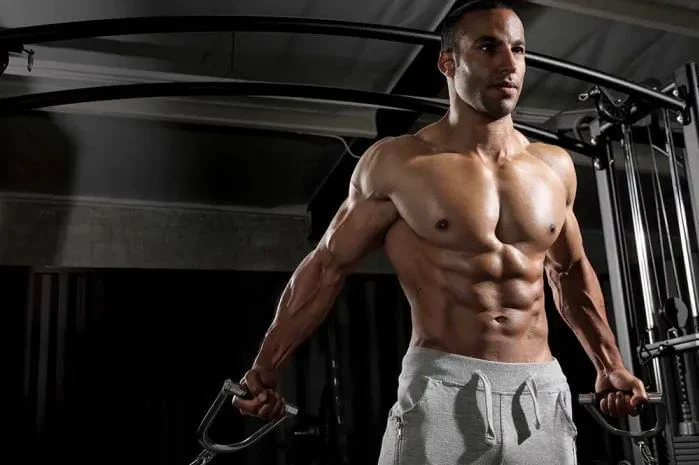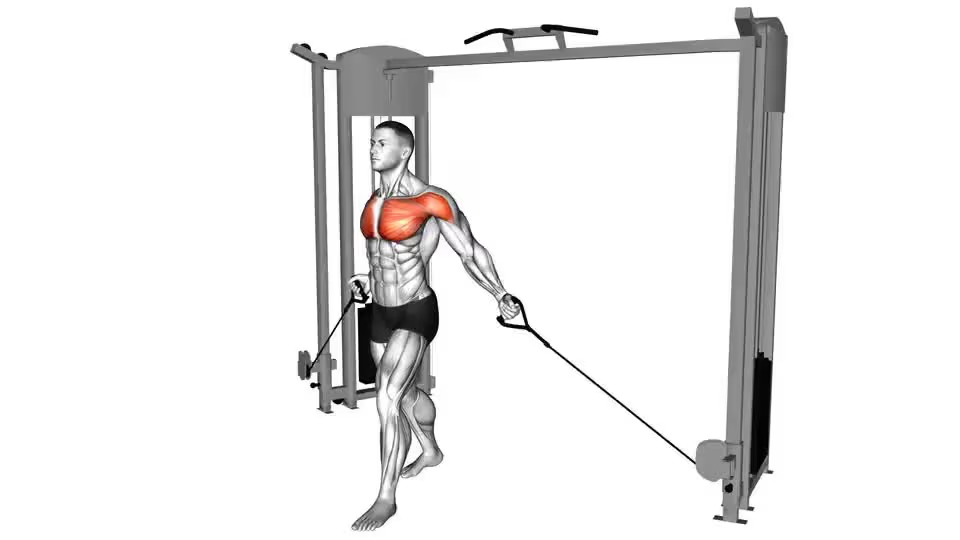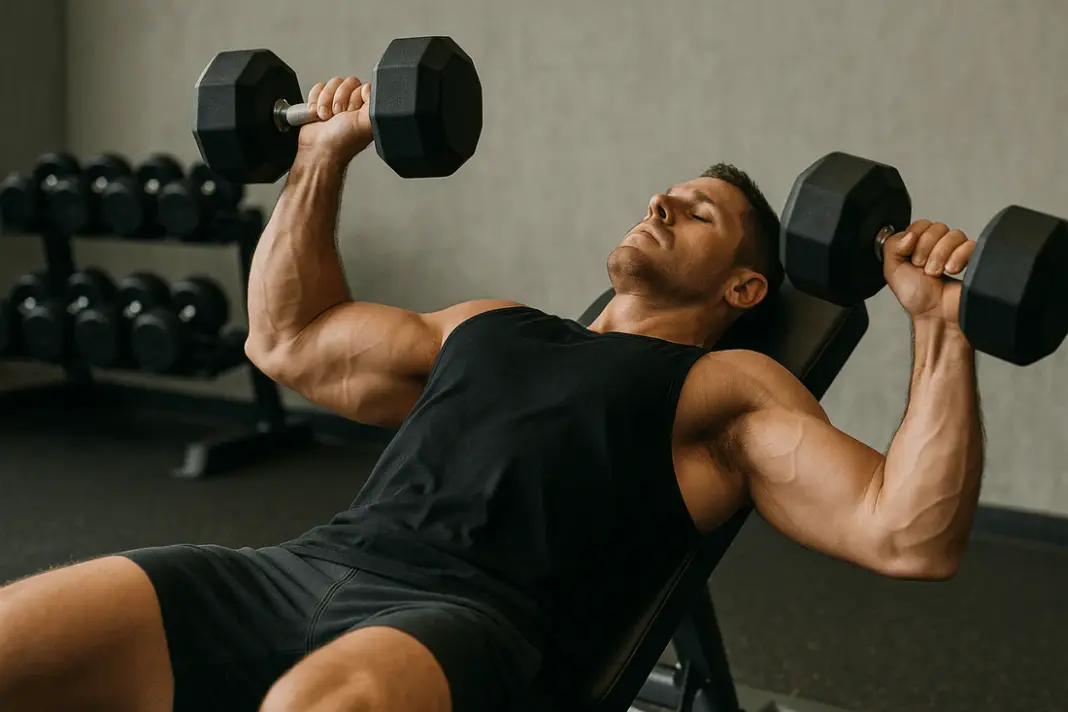Low-to-High Cable Fly: Carving the Upper Chest with Precision and Constant Tension
When it comes to shaping and defining the upper chest, few movements rival the Low-to-High Cable Fly.
This exercise isolates the clavicular head of the pectoralis major, giving you that carved, lifted, and full appearance at the top of your chest.
For bodybuilders, this is a refinement movement — it doesn’t just build mass; it shapes the muscle.
Unlike pressing variations that focus on load and power, the Low-to-High Cable Fly focuses on tension and direction, drawing fibers upward and inward to create that sculpted, high-chest sweep that frames the shoulders beautifully.
Whether you’re finishing an upper chest workout or targeting symmetry, this exercise is the go-to move for aesthetic detailing.
Muscles Worked
- Primary Muscle: Upper Pectoralis Major (Clavicular Head)
- Secondary Muscles:
- Anterior Deltoids (Front Shoulders)
- Serratus Anterior (Upper Ribcage Stabilizer)
- Biceps Brachii (Stabilization during the pull)
- Core Muscles (Stabilization throughout the fly motion)
What makes this exercise special is the direction of the resistance — the upward, inward arc emphasizes the upper pec fibers in a way no press can fully replicate.
Setup
- Cable Machine Height:
Set both pulleys at the lowest position on the cable tower. - Attachment:
Use D-handles for each side. - Positioning:
- Stand between the pulleys with one foot slightly forward (staggered stance).
- Hold one handle in each hand with palms facing forward.
- Keep a slight bend in your elbows (never locked).
- Retract your shoulder blades slightly and puff your chest up.
- Starting Angle:
- Begin with your arms slightly behind your body and low — feel a mild stretch in your chest.
- Your hands should be at or slightly below hip height at the bottom.
How to Perform the Low-to-High Cable Fly
Step-by-Step Execution
- Lift with Control:
- From the starting position, bring the handles upward and inward in a wide, arcing motion.
- Your hands should meet just above upper chest level (around collarbone height).
- Imagine you’re hugging upward around a large exercise ball.
- Squeeze at the Top:
- Bring your hands close together (without clashing handles).
- Squeeze your upper chest hard for 1–2 seconds.
- Controlled Return:
- Slowly lower your arms back to the starting position.
- Maintain slight tension at the bottom — don’t let the weights rest.
- Breathing:
- Inhale as you lower.
- Exhale and contract as you raise the cables upward.
Key Technique Cues
✅ “Hug upward, not straight forward.”
✅ “Lead with your chest — not your arms.”
✅ “Keep your elbows soft but fixed.”
✅ “Maintain cable tension through the entire range.”
✅ “Squeeze like you’re trying to touch your biceps together at the top.”
These cues reinforce the movement pattern that isolates the upper pecs while sparing the shoulders.
Programming Strategies
- Hypertrophy & Shaping Focus
This is where the Low-to-High Fly shines — tension, control, and contraction.
- Sets/Reps: 3–4 sets of 12–15 reps
- Tempo: 3 seconds eccentric, 1–2 seconds squeeze at top
- Rest: 45–75 seconds
- Goal: Maintain constant cable tension to maximize muscle fiber recruitment.
Use it as a finisher after compound presses to flood the upper chest with blood.
- Strength-Stability Variation
For those wanting to increase cable load control and shoulder balance:
- Sets/Reps: 3 sets of 8–10 reps
- Rest: 90 seconds
- Goal: Focus on stability and resistance management through a heavier load.
Keep the motion deliberate — no jerking or swinging.
- Pre-Exhaust Technique
Use this movement before incline pressing to pre-fatigue the upper pecs and amplify activation during compounds.
- Example Combo:
- Low-to-High Cable Fly – 3×15 (controlled tempo)
- Incline Barbell Press – 4×8 (heavy load)
This pairing enhances upper chest recruitment and deepens the pump.
Variations
- Single-Arm Low-to-High Cable Fly
- Great for isolating each side and correcting imbalances.
- Rotate slightly toward the active side for a deeper contraction.
- Cross-Body Cable Fly
- Cross one arm over the other at the top.
- Increases inner chest activation while maintaining upper chest tension.
- Kneeling Low-to-High Cable Fly
- Lowers your center of gravity and limits body sway.
- Excellent for isolation and focus.
- Resistance Band Low-to-High Fly (Home Alternative)
- Anchor resistance bands low and mimic the upward arc.
- Ideal for travel or home workouts where cable access is limited.
Common Mistakes & Fixes
- Overusing the Shoulders
- Mistake: Lifting primarily with front delts.
- Fix: Keep chest lifted and scapula retracted; lead with your chest, not your arms.
- Excessive Elbow Bend
- Mistake: Turning the movement into a press.
- Fix: Maintain a fixed 10–15° elbow bend — enough for joint safety, not load transfer.
- No Stretch or Control
- Mistake: Letting cables snap back at the bottom.
- Fix: Keep constant tension; the stretch phase is where much of the hypertrophy happens.
- Wrong Cable Height
- Mistake: Starting cables too high targets the mid or lower chest.
- Fix: Set pulleys at the lowest point to emphasize the upward pull.
- Overextending at the Top
- Mistake: Bringing handles too high (past forehead level).
- Fix: Stop when your hands reach upper chest height — that’s peak contraction range.
Advanced Techniques
- Time Under Tension (TUT) Focus
Perform each rep with 3–4 seconds on the eccentric, 1-second squeeze at top.
Enhances muscle fiber recruitment and metabolic stress.
- Drop Sets
After reaching failure, lower the weight by 25–30% and continue until second failure.
Delivers intense hypertrophy stimulus.
- 1½ Reps
Do a full rep, then half-rep at the top before lowering.
Increases the upper range workload for superior definition.
- Isometric Holds
Hold the contraction for 5–10 seconds after your final rep.
Builds endurance and deep fiber control.
Programming Example: Upper Chest Finisher
Workout Structure:
- Incline Barbell Bench Press – 4×6
- Incline Dumbbell Press – 3×10
- Low-to-High Cable Fly – 4×12–15
- Push-Ups (Feet Elevated) – 2xFailure
This sequence builds pressing power first, then sculpts with cable tension — maximizing both strength and shape.
Mind–Muscle Connection Cues
- Visualize the upper chest fibers shortening upward toward your collarbones.
- Keep your chest lifted and expanded through every rep.
- Don’t rush the eccentric — feel the muscle stretch under control.
- At the top, consciously squeeze from chest to midline, not from arms to hands.
This is one of the most effective exercises for developing neural control over your pecs — a key separator between beginners and advanced bodybuilders.
Bodybuilder’s Insight
The Low-to-High Cable Fly isn’t about ego lifting — it’s about refinement. Every rep should feel like you’re sculpting.
When done right, this movement brings out the upper chest separation and creates that crisp definition from collarbone to pec line that you see in elite physiques.
It’s also one of the best “pump finishers” you’ll ever experience. A properly executed cable fly will fill your upper chest with blood, tighten your skin, and make your chest look rounder and fuller almost instantly.
Train it with focus, tempo, and precision — not momentum.
Practical Takeaways
- Set cables low and wide to emphasize the upward contraction path.
- Keep your elbows slightly bent and fixed throughout.
- Focus on control, not load — let the pecs, not shoulders, do the work.
- Use high reps (12–15) and slow tempo for maximum fiber activation.
- Include this movement after presses for the best hypertrophy results.
- Use variations like single-arm or cross-body to fix imbalances and increase activation.
Conclusion
The Low-to-High Cable Fly is the sculptor’s tool for the upper chest — a precision movement that develops the top line, enhances definition, and ties the chest beautifully into the shoulders.
It’s not about how much you lift — it’s about how deeply you contract. When you perform this fly with perfect form and intent, you don’t just build muscle — you carve it.
Master the angle, feel the tension, and watch your upper chest transform from flat to full.




